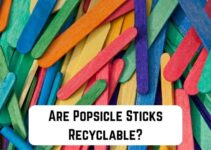When you look at items like footwear, clothing, handbags, furniture, and other equipment, one thing comes to mind, leather. Leather is a very versatile material that man has been using for over seven thousand years. A look at the fashion world is enough to tell you how important leather is to man.
Leather is a flexible, strong, and durable material produced from tanning animal skins and hides, the most common source being sheep, cattle, and goats. Other animals are also used to produce leather, but questions arise: with the increased production and usage of leather, what is its impact on the environment?
As important as leather is to man, can we say that it is sustainable and does not have a negative impact on the environment? We will provide answers to these questions and many more in this blog post. So, take a seat, relax, and enjoy reading this blog post.
Can You Recycle Leather?
Leathers are in great use today, and everywhere you go, you will find a product made from leather. This has caused many people to ask what will happen to the leather when they are old and not fit to be used. The best disposal method is recycling, and environmentally conscious people question whether leather can be recycled or not.
Yes, leather can be recycled. Leather scraps can be gathered from leather items and tanneries and used to create new leather items. Although, many recycling companies are reluctant to recycle leather. This is due to the difficulty in using old leather for new products.
Some people say the reluctance to recycle leather results from a lack of knowledge of the process, and others say time, money, and resources would be wasted during the process. Regardless of the reason, leather is not accepted in every recycling center. So, if you want to take old leather to a recycling facility, you need to check for a facility that accepts leather.
As leather is being used, the overall quality of the material deteriorates. Many people are unaware that most of the items they own will be recycled, so they do not use them and manage them properly. If people know that most items will be recycled, they will use them properly.
Is Leather Sustainable?
We have been made to believe that leather is a by-product of animal meat, so it is natural and sustainable. We believe that the animals used to produce leather are not killed for the leather, but the disposable remains of the animal skin are used to produce leather.
This is far from the truth; leather is not sustainable, many animals are killed to produce leather. There may be arguments that the sheep, cows, goats, and pigs are bred to provide meat, but animals like snakes, alligators, zebras, and crocodiles killed for their skin are not bred in farms. These animals are hunted and killed solely for their skin.
Poaching has become a global issue now; many animals are being hunted and killed for their skin to produce unique leather and other fashion accessories. We will not be dealing with poachers if the demand for exotic animal skin is not increasing.
The current state of the meat industry is neither ethical nor sustainable; it accounts for one of the largest sources of greenhouse gases that cause pollution. The industry emits about 14.5 percent of the annual greenhouse gases produced as a result of human activities.
To meet up with the increasing demand for leather, more animals needed to be bred. Some of these animals have been genetically mutated to speed up their development and reproduction process. These are unhealthy to the animals, and the process itself is not environmentally friendly.
Deforestation has been increasing because more space is needed to breed the animals for producing meat and leather. The more trees we cut down, the lesser the safety of the environment. Leather has been proven to have the greatest impact on eutrophication, and its production poses a threat to the safety of workers.
The process of producing leather is also not sustainable. The process is referred to as tanning, and it is done to prevent the animal skin from rotting. The chemicals used to tan hide are highly toxic; one of them is chromium. The hide is placed in a chromium salt bath; when the water is disposed of, it wreaks havoc on the environment, the ecosystem, and bodies of water.
Vegan leather is another type of leather that is available. Unlike leather, this material is produced from plants or other artificial materials. Vegan leather can be produced from apple peels, corks, pineapple leaves, as well as recycled plastic. Vegan leather has less impact on the environment than real leather. Its production also does not harm any animal, neither does it have any negative environmental impact.
The only unsustainable type of vegan leather is the ones produced from plastic; plastic has never been a sustainable material. It poses a threat to the environment when it is disposed of improperly. It takes a long time to degrade, and it releases toxins into the environment as it degrades.
Is Leather a Natural Fiber?
Natural fibers are any material produced from nature, including plants, mineral sources, and animals. All natural fibers are biodegradable, cheap, lightweight, strong, durable, and in natural abundance. To produce natural fibers, little synthetic product is needed. So is leather a natural fiber?
Nope, leather is not a natural fiber; you might assume that because leather is produced from animal skins, it is a natural fiber; on the contrary, it is not. Natural fibers are produced by spinning the raw materials into yarns and threads knitted or woven into natural fabrics.
Leather is produced through tanning; the hides are put into a tanning drum with a solution of vegetable tanning agents or chromium salts and rotated for about eight hours. The tanning agents soften the leather and preserve it. This process is very different from the process of producing natural fibers.
Natural fibers have a very soft and smooth texture, but leather is smooth with no texture. So, the fact that a material is produced from natural raw products does not mean it is a natural fiber.
Is Leather Bad For The Environment?
Most of the leather we use today is produced from cattle skins, although the skin of goats, sheep, and pigs is also used. Other wild animals are also hunted and killed specifically for their skins; they include bison, elephants, snakes, zebras, alligators, kangaroos, crocodiles, lizards, and ostriches. This has raised questions of concerns about the impact of leather on the environment.
Leather has a negative impact on the environment, and the impacts do not stop at the death of the animals used. Some of the environmental damages caused due to the production includes; ozone depletion, climate change, marine eutrophication, marine & terrestrial toxicity, greenhouse gas emissions, and fossil depletion.
Power production required to produce leather is one of the primary causes of these environmental damages. Some of the damages due to power production are greenhouse gas emissions, ozone depletion, terrestrial and marine toxicity. The wastewater from tanning leather is the major cause of marine eutrophication.
The way the animals are treated before their skins are used is also inhumane; the animals are abused in ways that are illegal for pets, their bodies mutilated, and their diet is barely enough to keep them alive. The chemicals used to preserve leather from rotting are also very dangerous to humans and the environment.
How Do You Dispose Of Leather?
The best way to dispose of any unwanted item is to recycle it; recycling is the most environmentally friendly way to dispose of old and unwanted items. However, if you own items that cannot be recycled, like leather, how do you dispose of them? The answer is to upcycle them; you can use the old leather to create new leather products.
1. Leather Pillow
You can use old leather furniture to make beautiful and slouchy pillows. To create a leather pillow, the leather has to be in good condition. The first thing to do is to cut out the size of the pillow from the leather and fine tune it to be a perfect square. Then, cut out the same size from another fabric of your choice.
Place the two fabrics together and sew them together with 1:2 inches seam allowance. Press the seam open and ensure you do not tan the leather again. Pin the zipper face down, sew and backstitch the upper part of the zipper to tack it in place. With the sides separated, sew both sides of the zipper.
Line up the other sides together and stitch them. Unzip the zipper a little and place the throw pillows you want to use inside, and finish unzipping it when everything is in place. Clip the threads and enjoy your leather pillow.
2. Leather Purse
To make a leather purse, you need to get a leather coat. First, cut the lining of the coat out and the exterior pieces you would not need. Seam rip the coat carefully, so the needle holes do not widen later. You can use the pre-existing hem of the coat when seaming so it will look more finished.
Using a 1:4 inch seam allowance and a leather needle, sew the bottom hem and sides of the leather. Ensure you fold the hem while sewing it. If you want the seams to lay nicely, you can use a tailor hammering block and a hammer and then finger press them. Fold the top hem down, measure and place, and install the grommets.
Cut out four strips of leather and sew two together, the wrong sides touching. Then sew two handle pieces through each side of the purse, flip the hem back up, and you have designed a leather purse.
3. Leather Pen Pot
An impressive upcycling idea for leather you can make for your children is a leather pen pot. You would need tin cans, faux leather from an old handbag, watercolor paints, a paintbrush, thread, and a needle.
First, cut the faux leather to size, cut the bag open with scissors and remove all the lining. Ensure you cut out leather that would be the same height as the tin and some centimeters longer than the tin’s diameter. Next, paint the leather you have cut out, and leave it to dry. You can choose to seal it with an acrylic spray sealer.
As soon as the paint is dry, stitch the two ends of the leather together, and slip the leather cover over the tin, and you have created a leather pen pot.
Conclusion
In our homes, there are many leather items we own and use. Leather is not as sustainable as we were made to believe it is, and we need to ensure we use and dispose of it properly. The impact of leather on the environment is great, so everyone must be careful using and disposing of them. We have provided several exciting upcycling ideas for leather. You should have a great time trying them out.
References:
https://moralfibres.co.uk/can-leather-be-eco-friendly/
https://www.huffpost.com/entry/leather-bad-for-the-envir_b_1696183
https://swoodsonsays.com/12-recycled-leather-projects-to-sew/






